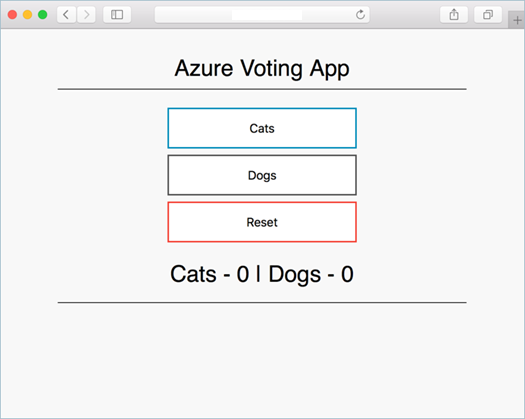Tutorial: Deploy applications in AKS enabled by Azure Arc
Applies to: AKS on Azure Local 22H2, AKS on Windows Server
You can build and deploy your own apps and services into a Kubernetes cluster when you're using Azure Kubernetes Service enabled by Azure Arc. Kubernetes provides a distributed platform for containerized apps. You can let the cluster manage the availability and connectivity.
This tutorial, part four of seven, describes how you can deploy a sample application into a Kubernetes cluster in AKS. You'll learn how to:
- Update a Kubernetes manifest file
- Deploy an application in Kubernetes
- Test the application
Later tutorials describe how to scale and update this application.
This tutorial assumes a basic understanding of Kubernetes concepts.
Before you begin
Previous tutorials described how to package an application into a container image, and then upload the image to the Azure Container Registry, and create a Kubernetes cluster.
To complete this tutorial, you need the pre-created azure-vote-all-in-one-redis.yaml Kubernetes manifest file. This file was downloaded with the application source code in a previous tutorial. Verify that you cloned the repo, and that you changed directories into the cloned repo. If you haven't done these steps, start with Tutorial 1 - Create container images.
This tutorial requires Azure CLI version 2.0.53 or later. Run az --version to find the version. If you need to install or upgrade Azure CLI, see Install Azure CLI.
Update the manifest file
In these tutorials, an Azure Container Registry instance stores the container image for the sample application. To deploy the application, you must update the image name in the Kubernetes manifest file to include the container registry login server name.
Get the Azure Container Registry login server name using the az acr list command, as follows:
az acr list --resource-group myResourceGroup --query "[].{acrLoginServer:loginServer}" --output table
The sample manifest file from the GitHub repo you cloned in the first tutorial uses the login server name of microsoft. Make sure that you're in the cloned azure-voting-app-redis directory, then open the manifest file with a text editor, such as Notepad:
notepad azure-vote-all-in-one-redis.yaml
Replace microsoft with your Azure Container Registry login server name. The image name is found on line 60 of the manifest file. The following example shows the default image name:
containers:
- name: azure-vote-front
image: mcr.microsoft.com/azuredocs/azure-vote-front:v1
Provide your own Azure Container Registry login server name so that your manifest file looks like the following example:
containers:
- name: azure-vote-front
image: <acrName>.azurecr.io/azure-vote-front:v1
Save and close the file.
Deploy the application
To deploy your application, use the kubectl apply command. This command parses the manifest file and creates the defined Kubernetes objects. Specify the sample manifest file, as shown in the following example:
kubectl apply -f azure-vote-all-in-one-redis.yaml
The following example output shows the resources successfully created in the Kubernetes cluster:
$ kubectl apply -f azure-vote-all-in-one-redis.yaml
deployment "azure-vote-back" created
service "azure-vote-back" created
deployment "azure-vote-front" created
service "azure-vote-front" created
Test the application
When the application runs, the Kubernetes service exposes the application front end to the internet. This process can take a few minutes to complete.
To monitor progress, use the kubectl get service command with the --watch argument:
kubectl get service azure-vote-front --watch
Initially the EXTERNAL-IP for the azure-vote-front service is shown as pending:
azure-vote-front LoadBalancer 10.0.34.242 <pending> 80:30676/TCP 5s
When the EXTERNAL-IP address changes from pending to an actual public IP address, use CTRL-C to stop the kubectl watch process. The following example output shows a valid public IP address assigned to the service:
azure-vote-front LoadBalancer 10.0.34.242 52.179.23.131 80:30676/TCP 67s
To see the application in action, open a web browser to the external IP address of your service:
If the application didn't load, it might be due to an authorization problem with your image registry. To view the status of your containers, use the kubectl get pods command. If the container images can't be pulled, see Authenticate with Azure Container Registry from Azure Kubernetes Service.
Next steps
In this tutorial, you deployed a sample Azure vote application to a Kubernetes cluster in AKS enabled by Arc. You learned how to:
- Update a Kubernetes manifest file
- Run an application in Kubernetes
- Test the application
Advance to the next tutorial to learn how to scale a Kubernetes application and the underlying Kubernetes infrastructure.
